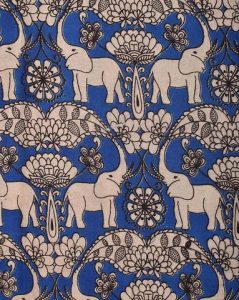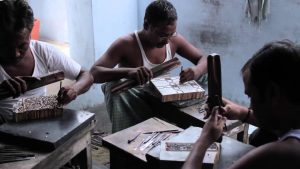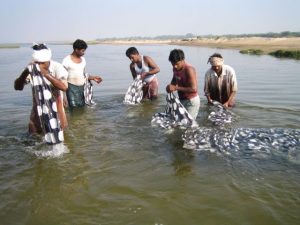World over, we see harmful effects of chemical dyes used on clothing. But, there is natural dyes work in textile like Kalamkari work. Kalamkari is usually pronounced as ‘qalamkari’ which is a type of hand-painted or block-printed cotton textile produced in parts of India and Iran. Its name initiates in the Persian which is derives from the words qalam (pen) and kari (craftsmanship) together it means drawing with a pen. The best part about kalamkari is highly appreciable – only natural dyes are used in it. The craftsmanship work in this art involves many tedious steps. Each design takes several days of concentrated effort to complete, as the process of dyeing and hand printing are very intricate and tiresome. Many stages have to be undergone before the final results are achieved. Unlike other styles of painting, Kalamkari painting demands a lot of treatment before and after the painting is completed on the cotton fabric.
There are two distinctive styles of kalamkari art in India: the Srikalahasti style and the Machilipatnam style. The craft has been in existence from about a thousand years, but gained the height of its popularity during the 15th century. Today the two main centers of Kalamkari production are Machilipatnam and Kalahasti in the State of Andhra Pradesh. The work from these two places is also different from each other. The themes a re mythological, mostly from the Ramayana and the Mahabharata. In addition, block-painted textiles by hand are also produced.
re mythological, mostly from the Ramayana and the Mahabharata. In addition, block-painted textiles by hand are also produced.
Depending on the treatment of cloth, or quality of the mordant, the colours change accordingly. Every step from soaking of the cloth, to sketching the outlines to washing and drying the cloth, is done carefully and correctly. The harmless, naturally dyed fabrics are used for Kalamkari paintings. Only four colours are used. The colour red is obtained by using the Indian madder root, yellow from the pomegranate seed or even mango bark, blue from indigo, and black from myrobalan fruit – which is a tropical cherry plum. No chemical dyes are used is producing Kalamkari colours.
The process used for both schools of Kalamkari painting is more or less the same. The only major difference is that ‘Srikalahasti’ paintings depend entirely on the brush-like pen, whereas the Machilipatnam style uses block-printing procedures. The process done in Srikalahasti is more tedious. The cloth is treated and washed twice, and alum is painted for two or three time.
The different Stages:
- The cloth is first whitened by immersing it in a solution of goat or cow dung and letting it dry in the Sun for a few days. The cloth is then treated in Myrobalan solution. Myrobalan dyestuff consists of ground nuts of the Terminalia chebula This tree grows in Nepal, India, Sri Lanka, Burma, Thailand, Indochina and south China. It may be classed as both a mordant and a dye, giving a light buttery yellow when applied. Ripe fruits are used in Machilipatnam style and raw ones in Srikalahasti. Milk is then added to the solution to prevent the colour from spreading in the next step. Then iron acetate solution is filled in, either for solid spaces or as outlines. In Srikalahasti style a pen-brush is
 used and in Machilipatnam wooden blocks are used.
used and in Machilipatnam wooden blocks are used. - All the areas meant to be red are painted or printed over with the alum solution as a mordant. Mordant is a substance that fixes the natural dye on the material. After applying alum, the cloth is kept for at least 24 hours. Then the excess mordant is removed by washing the cloth under flowing water.
- The dyeing is done for the red colour by boiling with the red colouring materials. All the portions that are not to be blue are covered with wax. The waxed cloth is immersed in indigo solution. In Srikalahasti, the blue is painted with the kalam. Then the wax is removed by boiling the cloth in water. The yellow is painted on to produce yellow and green.

- The cloth is finally washed again and dried before the final colours emerge. However, the use of vegetable dyes and mordants make it still a time consuming process.
- Dyes for the cloth are obtained by extracting colors from various roots, leaves, and mineral salts of iron, tin, copper, and alum. Various effects are obtained by using cow dung, seeds, and plants and crushed flowers to obtain natural dyes. Along with buffalo milk, myrobalan is used in kalamkari. Myrobalan is also able to remove the odd smell of buffalo milk. The fixing agents available in the myrobolan can easily fix the dye or color of the textile while treating the fabric. Alum is used in making natural dyes and also while treating the fabric. Alum ensures the stability of the color in kalamkari fabric.
- The theme for designs on cloth are filled in with the colors which are entirely hand worked. This style is usually flowered around temples and their rituals. Therefore, this style of craftsmanship concentrates an almost religious identity in form of scrolls, temple hangings, chariot banners and the like, which depict deities and scenes taken from the Hindu epics of Ramayan, Mahabharata, Puranas and other mythological classics. This style owes its present status to Kamaladevi Chattopadhayay who popularized the art as the first Chairperson of the All India Handicrafts Board. However, few of the recent applications of the kalamkari technique depict Buddha and Buddhist art forms
The Machilipatnam Kalamkari craft is produced at Pedana near by Machilipatnam in Krishna district, Andhra Pradesh which revolves around designs and pictures from Mughal and Golconda sultanate. In Iran, the fabric is printed using patterned wooden stamps. Though the name of the art is Machilipatnam Kalamkari, it is produced at the nearby town of Pedna Krishna District of the Indian State of Andhra Pradesh. It was registered as one of the geographical indication from Andhra Pradesh under handicrafts goods by Geographical Indications of Goods (Registration and Protection) Act, 1999.
Kalamkari sarees and, dress material gives a majestic look to the user. Even the handicraft items made by Kalamkari designs are fabulous.













































